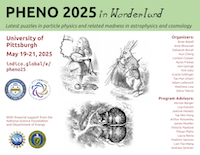Speaker
Description
The KM3NeT collaboration recently reported the observation of KM3-230213A, a neutrino event with an energy of 220 PeV, nearly an order of magnitude more energetic than the highest-energy neutrino in IceCube’s catalog. Despite its larger effective area and longer data-taking period, IceCube has not observed similar events, leading to a tension quantified between ~2$\sigma$ and 3.5$\sigma$, depending on the type of neutrino source.
The 220 PeV neutrino detected at KM3NeT has traversed approximately 147 km through rock and sea, whereas neutrinos from the same location in the sky would cross only about 14 km of ice to reach IceCube. In this talk, I will show how differences in propagation distance can help resolve this tension. Specifically, I will present a scenario where the source emits sterile neutrinos that partially convert to active neutrinos via oscillations. I will present two such mechanisms: one where a new physics matter potential induces a resonance in sterile-to-active transitions, and another involving off-diagonal neutrino non-standard interactions. In both cases, oscillations over ~100 km enhance the active neutrino flux at KM3NeT with respect to the flux at IceCube. Overall, we propose the exciting possibility that neutrino telescopes have already started detecting signatures of physics beyond the Standard Model.

